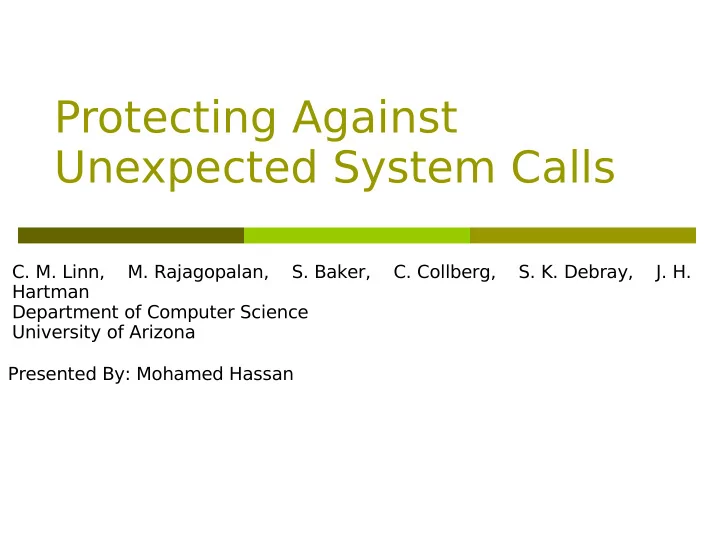

Protecting Against Unexpected System Calls C. M. Linn, M. Rajagopalan, S. Baker, C. Collberg, S. K. Debray, J. H. Hartman Department of Computer Science University of Arizona Presented By: Mohamed Hassan
Code Injection What is a system call? What is code Injection? How it works? Exploit a vulnerability in a program (usually a server) Introduces the attacker code into the program Trick the program to run the attacker code To do real damage (get root shell, change permissions,..) the attacker code will execute one or more system calls
How to defeat it? Use a mix of defense mechanism to prevent code injection Defense mechanisms Novice: Interrupt address table (IAT) Disguising system call instruction Code Pocketing Existing ones Dead and useless code insertion Randomization and Binary obfuscation
Some Basics System call mechanism Load arguments in registers EBX, ECX, EDX, ESI and EDI (if more push it on the stack) Load syscall number into EAX Execute “int 0x80” HW Pushs PC on the stack (next instruction) Pass control to the kernel ELF (Executable and Linkable format) Extensible Binary file format It contains a Header that describes the subsequent sections that contain code, data, bss and GOT Dynamic Vs Static linking?
More basics Static linking Reference to library function are included during compile-time/link-time. Dynamic Linking Linked during runtime by the dynamic loader Each routine has unique entries in the GOT (global offset table) and PLT (procedure linkage table) In lazy binding, these entries points to the dynamic linker which will locate the referenced routines (first call only) and update the GOT and PLT tables In eager binding, the linker will resolve all entries during the setup phase of he program
Attack Model The attacker ultimate goal is to execute a system call How? Attacker code invoke the system call directly (direct) Attacker will scan the code for a function that makes system call (mimicry attacks)
Prevention I (Direct System call attack) Interrupts Address Table (IAT) Add semantic information about the system calls invoked in the program Each system call entry in the IAT of the next instruction and the system call number The IAT is stored in an internal data structure in the kernel (Why?) In dynamic linking, the linker will load the library IAT If an attacker calls a system call and the call is not in the table or the next instruction (on the stack) doesn’t match any then it is an intrusion
Prevention II (code scanning attack) Disguising System Calls Replace system calls with faulting instructions (div by zero) Kernel lookup the IAT and if it is a disguise the kernel executes the correct Instruction Hiding the location of functions that make a system call Delete all symbol information that refers to linked functions What about dynamic linking? (it needs the these information) Unmap the shared object’s symbol table Add fake entries in the PLT and GOT
Prevention II Cont’d If the attackers cannot fine system call or functions they will scan for byte sequence (fingerprints) To prevent this: Add dead and useless code such as nop; add $0 , r; push r; pop r; Layout randomization and binary obfuscation Pocketing
Experiment and Results Target m88ksim (it has a lot of system calls) Devised an attack for each case: Known address attack Scanning attack Identify system calls directly Identify functions that will lead to system calls All the these synthetic attacks were unsuccessful
Cost (Overhead) IAT checking overhead on average (SpecInt-2000) Runtime/system call: 0.25 usec File size: 0.11% Memory Size: 0.45% Total exec time: 1.7% Transformation costs (to avoid scanning attacks) Randomization and nops :Much smaller than other optimization techniques Pocketing: 85% overhead
Take Away If you can integrate related ideas together in a reasonable manner, you can end up with a good idea Criticism Many, much , few (Do the math) Review the paper before submittingx
Recommend
More recommend